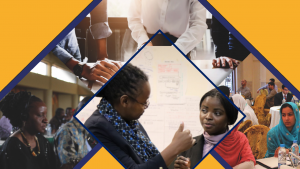‘Reading organizations’: a new diagnostic tool to improve knowledge to policy systems
Clara Richards, Senior Programme Manager, Evidence-Informed Policy Making Team, INASP introduces a series of posts on new approaches for organizational change
Over the four years in which INASP and Politics & Ideas have been improving knowledge to policy systems, we have heard a great deal about the complex context within which public agencies operate. Recognizing the need for new approaches to address this complexity, we developed the ‘Context Matters’ framework. The framework summarizes key organizational factors influencing how government agencies use – or don’t use – knowledge. This year, we are ready to apply it as a new diagnostic tool to improve the use of knowledge in policy within a government agency. We will use the tool to:
- diagnose the current state of knowledge production and use in a government agency
- identify areas that have potential to catalyse change
- co-produce a feasible change plan that reflects the agency’s realities and possibilities
Finding a government agency open to a new approach
For successful organizational change we need to be responsive to countries’ realities; work with highly-motivated teams; avoid pitfalls by ‘taking the money off the table’; and provide space for an experience-based design process where there is room for iteration, adaptation and learning. With these principles in mind, we designed the terms of reference that would attract teams interested in working in this way and put out a call for proposals. We were lucky to receive many applications, demonstrating demand for this work. Together with a review team we finally selected an application by the Secretary for Public Administration (SGP) in Peru because they shared these principles, demonstrated a strong commitment, have already developed mechanisms for improving knowledge use that can be build upon. Further there is potential for scaling up this apprach within the State as the SGP deals with various policy topics and several ministries and secretaries. An added value was the joint application with CIES, a consortium of 48 think tanks and universities in Perú, with track record in investing in the use of research in policy.
Why we need new approach to organizational assessments
Diagnostic tools help make sure interventions are of better quality and as relevant as possible to an organization’s reality and context.
Ownership and participation
Many diagnostic or organizational assessments are carried out as tick box exercises, sometimes by an external group of researchers. These approaches lead to a partial understanding of an organization as a dynamic, complex and highly contextual entity. However, if done in a participatory way – co-creating during the process – diagnostic exercises can be an opportunity for a team to take ownership in the first step of a change process. It is a chance to take a step back and look at the organization (or department) as whole, to identify those areas that have potential for catalysing change and an opportunity for individuals and groups to develop awareness of how they are affecting their work.
Adaptation and learning
Another pitfall is that diagnostic tools often focus solely on the visible, tangible element of an organization: for example, its processes and systems for budgeting, planning and reporting. While these are all important, we need to go a step further and look at the hidden elements that make an organization behave in certain ways. These softer elements, such as openness for change, beliefs, values, motivations, power and leadership, have proven to be crucial factors in how knowledge is produced and used. Working with a team to help them walk the journey themselves, explore these softer elements and discover what solutions emerge is a key feature of our organizational diagnostic approach and the design that underpins our framework.
Jan Ubels et al. call this approach ‘reading organizations’. ‘Reading’ reveals hidden and unarticulated aspects, such as the unseen messages that lie underneath activities, behaviours and interactions. In this way, the organization is fully involved in its own evolution to improving knowledge to policy systems. As Ubels states:
‘reading organizations’ “results in a deeper self-knowledge within the organization, with greater confidence to accept both its potential to excel and difficult issues that must be confronted.”
Relationships
Finally, the approach we will take for implementing our diagnostic tool pays particular attention to relationships. Our framework identifies inter and intra relationships that influence how knowledge interacts (or not) with policy. Inter relationships are between the organization (i.e. the government agency in question) and other related government agencies. Intra relationships are the interactions between users and producers of knowledge who can affect or be affected by policy design and implementation. Studies suggest that paying attention to the quality and nature of what’s happening between and within groups can bring about change beyond the government agency itself.
While diagnostic exercises and organizational assessments might not currently use the most innovative concepts, the new ‘reading organizations’ approach – which involves adaptation, learning, participation and ownership – could result in organizational change that better improves the use of knowledge in complex political contexts.
Next steps
We look forward to working with the Secretary for Public Administration in Peru to apply our new diagnostic tool and approaches. If you are interested in finding out more about how our work progresses over the coming months, please sign up to our newsletter: inasp.info/signup

 Previous Post
Previous Post


